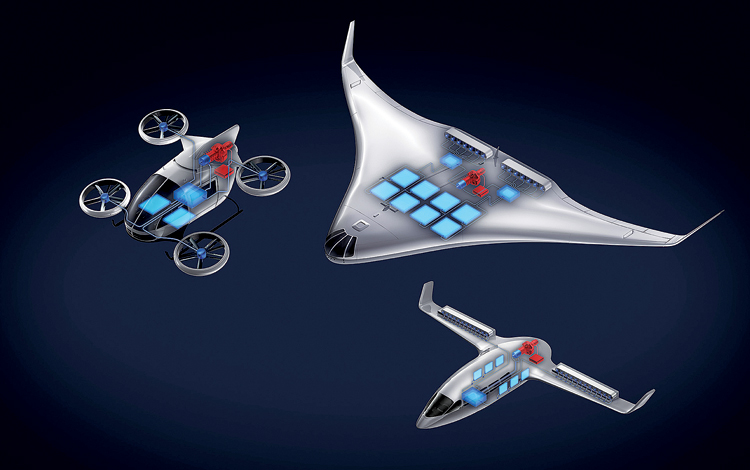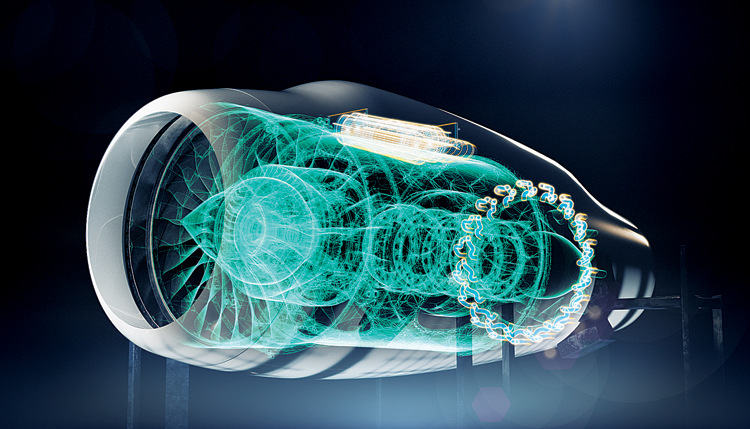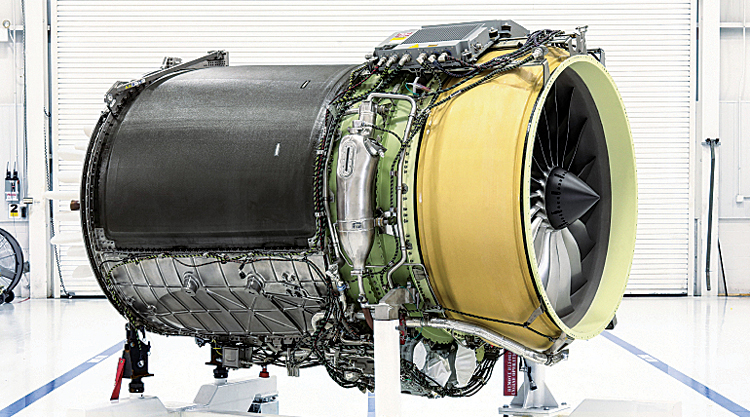Aero Engines manufacturers are aiming for Sustainable Aviation, seeking solutions to improve the environmental and societal impacts of air transportation

The open fan design is one of the advanced engine architectures that CFM International is exploring through the CFM RISE Program
Since the beginning of the industrial age in the 18th century, carbon-based fuels have come to dominate global energy use. World’s dependency on them has led to alarming increases in air pollution and global warming. The aerospace industry is a major consumer and fast expanding player. The aviation sector accounts for about 6.0 per cent of total oil consumption worldwide. It needs to take bold steps towards reducing its greenhouse gas emissions. The aero-engine manufacturers along with the airframe integrators need to increase sustainability. Commercial airlines around the world consume a staggering 370 billion litres of fuel a year, with air travel accounting for over two per cent of global carbon dioxide (CO2) emissions annually. It is predicted that traffic will grow five per cent per year to 2026 and fuel demand three per cent per year. The demand for jet fuel and aviation gasoline in the air transport sector is projected to reach 14 per cent of fuel demand in transportation in 2035, compared to 12 per cent in 2009.
The aerospace industry has set the ambitious target for the year 2050 to reduce its net greenhouse gas emissions by 50 per cent compared with 2005 levels – but at present it is not on track to achieve them. But all aero-engine Original Equipment Manufacturers (OEM) are very actively developing latest technologies that will help to reach this objective. These include better engine efficiency, and hybrid propulsion technologies such as bio-gas, electric, solar, hydrogen-powered, among others.
GREEN AVIATION
The terms ‘Sustainable Aviation’ or ‘Green Aviation’ are increasingly being used to address the technological and socio-economic issues facing the aviation industry. Because the majority of aircraft emissions are injected into the upper troposphere and lower stratosphere, the resulting impacts are unique. The impact of burning fossil fuels at altitude is approximately double that due to burning the same fuels at ground level. Therefore, there is an urgency to address the problems of emissions through technological innovations. The most important role in an airplane’s fuel efficiency is of the engines. The two most widely used aircraft today - the Boeing 737 and the Airbus A320 have shown that newer models carry more passengers and payload while burning 23 per cent less fuel.
SAGE INITIATIVES
‘Sustainable and Green Aero-Engines’ initiatives are being taken both in the European Union and in the United States to develop aero-engine technologies with new engine architectures that offer opportunities for reduction in CO2 emissions. Emissions of CO2, H2O, O2 and N2, which are products of hydrocarbon fuel combustion, are all functions of engine fuel burn efficiency. Areas being addressed are lightweight low pressure systems for turbofans, including composite fan blades and high efficiency low pressure turbine; advanced engine externals and installations including novel noise attenuation; high efficiency Low Pressure (LP) spool technology while further advancing high speed turbine design; option of an aggressive mid-turbine inter-duct; high efficiency and lightweight compressor and turbine; and low emission combustion chamber for next generation rotary-craft engine. Developments in controls and electronics, lightweight metallic and composite materials, hydraulic and pneumatic systems, novel manufacturing methods, specific aero-engine parts such as casing, tanks, pipes, high temperature materials such turbine blades and sensors would require attention.

Pratt & Whitney and Collins Aerospace in Hybrid-Electric Propulsion Technology with New STEP-Tech Demonstrator
European Union’s SAGE 2 project headed by Rolls-Royce and Safran focuses on demonstrating the technologies such as composite propeller blades with aero-acoustic optimisation, electric de-icing system and equipment. The gas generator used in the SAGE 2 open rotor demonstrator is derived from a Snecma M88 engine. The current status plan is to use the Airbus A340-300 MSN001 test aircraft as a flight test vehicle, with one full size Contra Rotating Open Rotor (CROR) pusher engine attached to a representative pylon and engine mount. Open rotor technologies offer the potential for significant reductions in fuel burn and CO2 emissions relative to turbofan engines of equivalent thrust. Open rotor engines remove the limitation by operating the propeller blades without a surrounding nacelle, thus enabling ultra-high bypass ratios to be achieved. Installation of the open rotor engine on the airframe has its complexities, as the airflow through the propellers interacts with the supporting airframe structure in a different manner. The trend to Very High Bypass Ratio (VHBR) engines requires technology developments across a broad range of complex gas turbine systems, from fan inlet through the complete compression, combustion and turbine to exhaust.
NEW ENGINE DESIGNS AND CONCEPTS
Two new engine concepts currently under investigation include the ‘Combined Brayton Cycle Aero Engine’ and ‘Multi-Fuel Hybrid Engine’. Even though modern engines are supposedly very efficient, over 50 per cent of the energy input is ejected as waste heat. Improving performance by heat recovery is the requirement. A heat exchanger integrated in a turbofan core can convert recovered heat into useful power which can be used for on-board systems or to power an electrically driven fan to produce auxiliary thrust. A dual combustion chamber, with first stage between HP Compressor and HP Turbine burning Hydrogen/Methane cryogenic fuel or liquid natural gas and the second combustor at an inter-stage uses kerosene/bio-fuel in the flameless combustion mode, is being considered. High temperature generated in the first stage, allows flameless combustion in the inter stage thus reducing CO2 and NOx emissions. Cryogenic bleed air cooling can enhance the engine thermodynamic efficiency by cooling the bleed air thus allowing increase in temperature of the fuel. Contra-Rotating Fans can use boundary layer ingestion to reduce both noise emission and improve propulsive efficiency.
HIGH BY-PASS RATIO ENGINES
High by-pass ratio (HBPR) turbofan engines like CFM International’s LEAP use less fuel, while winglets (vertical extensions of wingtips) improve the airflow around the wing, reducing fuel burn and increasing cruising range. Increased use of carbon fibre composite materials in airframe construction are displacing conventional metals and have made significant weight reductions, leading in turn to savings in fuel. HBPR turbofans like the Rolls-Royce Trent XWB are among the most efficient flying in the world today, while the company’s Trent 1000, in service on the Boeing 787 Dreamliner, has already undergone tests using 100 per cent sustainable aviation fuel (SAF) on Rolls-Royce’s flying test-bed.
OPEN ROTOR CONCEPT
The open rotor concept, is an advanced evolution of the existing HBPR turbofans. It eliminates the need for a fan duct in the conventional cased turbofan engine Open rotor engines offer a high propulsion efficiency, and in turn significantly reducing fuel consumption. GE and Safran have been working on open rotors. In June 2021, GE launched the CFM RISE (Revolutionary Innovation for Sustainable Engines) programme targeting 20 per cent lower emissions (GE and Safran are together in CFM International). Their open fan architecture and hybridelectric capability, with engines that could enter service by the mid-2030s. Still to be resolved is excessive rotor noise that comes with open rotor. Improvements in material technology and digital modelling could further reduce engine size, weight and noise. RISE engines could have hydrogen-burning versions, with much improved fuel efficiency. Meanwhile Airbus has launched a Zero Emission Development Center (ZEDC) for hydrogen technologies in the UK for its ZEROe aircraft.

Artist’s impression of Rolls-Royce Hydrogen engine ground test
Rolls-Royce is also working on an open rotor engine concept. Their Advance3 programme will be a three shaft engine, two-stage high pressure turbine and a single-stage intermediate pressure turbine. These include: a project to develop Silicon Carbide-based Ceramic Matrix Composite technologies for future engine architectures. The engine will have a new engine core and ALECSys (Advanced Low Emissions Combustion System). UltraFan is their demonstrator aero engine – the largest in the world, containing a suite of new technologies that deliver greater fuel efficiency, which in turn means lower emissions and greater sustainability. The thrust range would be 25,000 lb to more than 1,00,000 lb, for narrow-body or wide-body aircraft that may be developed from the 2030s. It will deliver 25 per cent fuel efficiency and lower emissions compared to the Trent.
ELECTRIC PROPULSION
Hybrid-electric and all-electric applications are being evolved especially for the urban air mobility (UAM), commuter and regional aircraft. ACCEL (Accelerating the Electrification of Flight) is an electric aircraft demonstrator developed by Rolls-Royce. On September 15, 2021, Rolls-Royce announced the aircraft, named “Spirit of Innovation”, had successfully completed its first flight. It subsequently reached a top speed of 622 km/h and made a world record. The 7.3 m span aircraft is powered by three high power density electric motors driving a single three-blade propeller spinning at 2,400 RPM, designed and manufactured by YASA. The 750 volt, 216 KWh battery has 6,480 cells. It is designed to have the highest energy density for an aircraft, and should allow a 310 km range. Rolls-Royce intend the battery, motors and control equipment in a production system to weigh the same as the regular engine and fuel tank in a conventional aircraft, but the battery pack alone in the Spirit of Innovation currently weighs 1,350 kg.
SUSTAINABLE AVIATION FUEL (SAF)
Sustainable Aviation Fuel (SAF) or also referred to as Bio-fuels would be long-term alternatives to fossil fuels. SAF is produced from feed-stocks like cooking oil and other non-palm waste oils from animals or plants, as well as solid waste from homes and businesses, such as packaging, paper, textiles, and food scraps that would usually go to landfill or incineration. SAF can be mixed at up to 50 per cent with traditional jet fuel and the blend is then re-certified. It has the potential to provide a carbon reduction of up to 80 per cent compared to the traditional jet fuel it replaces. Pratt & Whitney announced on March 15, 2022 that it had successfully tested its new GTF (Geared Turbo Fan) Advantage engine configuration with 100 per cent SAF, with entry into service expected in 2024. On November 9, 2021, an Airbus H225 performed the first ever helicopter flight with 100 per cent SAF powering one of the Safran Makila 2 engines. It offers a net 90 per cent CO2 reduction compared to regular jet fuel. The downside for SAF currently is that it is more costly to produce than traditional fossil jet fuel.
EFUELS
Electricity-based eFuels and biogenic synthetic fuels are the alternative to conventional liquid fuels and are therefore ideally suited to reduce CO2 emissions decisively and affordably in the transport and heating market - all the way to climate neutrality. eFuel production is based on the extraction of hydrogen. An electrolysis process that breaks down water into its components of hydrogen and oxygen. Electricity is required for these processes. Using Fischer-Tropsch synthesis, the hydrogen is then combined with CO2 extracted from the air and converted into a liquid energy carrier: eFuel. Under high pressure using a catalyst, the hydrogen binds with the CO2. After processing in refineries, this eFuel can be used as eGasoline, eDiesel, eHeating oil, eKerosene and eGas and can completely replace conventional fuels. Existing logistics, distribution and refueling infrastructures, such as tank farms, tank lorries, pipelines and filling stations, can continue to be used. The climate neutrality of eFuels derives from the fact that electricity from renewable energies is used in their production and only as much CO2 is emitted during use as was previously bound during production. They are compatible with today’s internal combustion engines. eFuels such as e-hydrogen, e-methane, e-methanol, e-diesel or e-ammonia can be converted into electricity and propulsive power. Rolls-Royce is currently working on various initiatives.
HYDROGEN – AN EFFICIENT SOLUTION
Hydrogen propulsion could be a great long-term solution, but again, like SAF, cost is currently a barrier. Hydrogen can be created from water and electricity, allowing it to be produced from clean, renewable energy sources. Hydrogen fuel cell aircraft would be completely free from pollutant exhaust emissions, including particulates, oxides of nitrogen, carbon monoxide, and eliminating CO2 and reducing nitrogen oxide (NOx) emissions by 80 per cent.
RETROFITTING OLD AIRCRAFT
Industry analysts believe that 20,000 aircraft are currently suitable for retrofitting with electric/hybrid propulsion technology. Financers are more willing to support such a transition. The Raytheon’s Collins Aerospace is “exploring potential hybrid-electric and all-electric solutions for rotorcraft and urban air mobility (UAM) platforms. Hybrid-electric and all-electric propulsion would also mean reductions in noise, fuel consumption, carbon emissions, and operation and maintenance costs.
SEEKING SUSTAINABILITY
GE’s upcoming GE9X turbofan is the most fuel-efficient engine in its class. Over the coming years, GE also intends to demonstrate some key technologies and advanced engine architecture such as open fan and hybrid-electric propulsion systems, as well as new compact engine cores. It will also actively support the use of alternative fuels, such as Sustainable Aviation Fuel (SAF) and hydrogen, and harness digital technologies to help make the industry more sustainable.

Engineers are working to modify a GE Passport engine to make it fully compatible with liquid hydrogen fuel
Since June 2021, GE has focussed on the next generation of engines and has launched three key demonstration programmes. First off the blocks was CFM’s RISE (Revolutionary Innovation for Sustainable Engines) Technology Demonstration Program, with its open fan configuration. Second, a partnership with the National Aeronautics and Space Administration (NASA) to develop a megawatt-class hybrid-electric propulsion system. At the Farnborough International Airshow in June 2022, GE and NASA jointly announced that they have become the first to successfully test high-power, high-voltage hybrid-electric engine components in conditions simulating altitudes up to 45,000 feet. Third, and most crucially, a partnership between Airbus and CFMI to conduct flight tests of a hydrogen-powered engine. Hydrogen is the only path to a true zero-emission aircraft and the genuine sustainability of aviation. In February 2022, CFMI signed an agreement with Airbus to collaborate on a hydrogen demonstration programme that will take flight around the middle of this decade. The engineers at CFMI are working to modify a GE Passport engine to make it fully compatible with liquid hydrogen fuel. This includes a complete overhaul of its combustor, fuel system and controls system. The modified jet engine will be mounted on the rear top of the fuselage of an Airbus A380, powered by its original four engines. But the experimental configuration will allow the team to test the hydrogen-powered engine’s emissions, including contrails, and monitor them separately. This is in preparation for entry-into-service of a hydrogen-fuelled commercial aircraft by 2035.
WAY AHEAD INDIA
The IAF has target of flying 10 per cent its fleet on a blend of bio-fuel. Mangalore Refinery and Petrochemicals Limited (MRPL) has set a target of starting the commercial production of bio-fuel by 2024. The ultimate aim is to fly fighter aircraft with bio-jet fuel as the United States Air Force (USAF) did in 2010. India’s IndiGo airline completed it’s first-ever flight using sustainable aviation fuel (SAF) in February 2022. IndiGo signed an agreement with CSIR-IIP to manufacture sustainable aviation fuel. Clearly India too is working closely for greener aviation.












